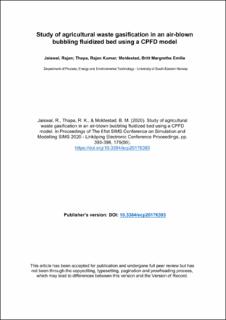| dc.contributor.author | Jaiswal, Rajan | |
| dc.contributor.author | Thapa, Rajan Kumar | |
| dc.contributor.author | Moldestad, Britt Margrethe Emilie | |
| dc.date.accessioned | 2021-07-26T11:29:39Z | |
| dc.date.available | 2021-07-26T11:29:39Z | |
| dc.date.created | 2020-12-28T12:54:28Z | |
| dc.date.issued | 2020 | |
| dc.identifier.citation | Jaiswal, R., Thapa, R. K., & Moldestad, B. M. (2020). Study of agricultural waste gasification in an air-blown bubbling fluidized bed using a CPFD model. In Proceedings of The 61st SIMS Conference on Simulation and Modelling SIMS 2020 - Linköping Electronic Conference Proceedings, 176(56). | en_US |
| dc.identifier.issn | 1650-3686 | |
| dc.identifier.uri | https://hdl.handle.net/11250/2765272 | |
| dc.description.abstract | Gasification using a fluidized bed is a promising technology to convert agricultural residues into product gases. In this work, the syngas production potential from agricultural waste (grass pellets) is studied using computational fluid dynamic. A CPFD model is developed in a simulation software Barracuda virtual reactor and validated against the experimental data. Experiments are carried out in a 20 kW bubbling fluidized bed gasification reactor that operates with air as fluidizing gas. Grass pellets of size 5mm-30 mm in length and diameter of 5mm are used as the feed. The CPFD model considers the hydrodynamics of the gas-solid phase and reaction kinetics involved. Influence of the static bed height, bed temperature, and air to fuel ratio on the product gas composition (CH4, CO, CO2 and H2) and char conversion efficiency are investigated. Initial bed heights of 200 mm and 300 mm are used for the analysis. Biomass is fed at 2.46 kg/h while the air supplied is varied to obtain the air to fuel ratio at 0.4, 0.6, 0.8, 1, and 1.2. The result shows that the increase in bed height has a significant effect on the reactor temperature but very small effect on the product gas composition and char conversion rate. An increase in bed temperature from 600 oC to 800 oC improves the gasifier performance in terms of maximum product gases yield and enhanced char conversion rate. Increase in the air to fuel ratio from 0.4-1.2 reduces the CH4, CO and H2 fractions in the product gas and increases the CO2 concentration. The results obtained from the CPFD model are in good agreement with the experimental results and literature data. Thus, the CPFD model developed in this work can be utilized to optimize the gasification reactor used in a lab and industrial scale. | en_US |
| dc.language.iso | eng | en_US |
| dc.rights | Navngivelse-Ikkekommersiell 4.0 Internasjonal | * |
| dc.rights.uri | http://creativecommons.org/licenses/by-nc/4.0/deed.no | * |
| dc.title | Study of agricultural waste gasification in an air-blown bubbling fluidized bed using a CPFD model | en_US |
| dc.type | Journal article | en_US |
| dc.type | Peer reviewed | en_US |
| dc.description.version | acceptedVersion | en_US |
| dc.rights.holder | © The Author(s) 2020. | en_US |
| dc.source.volume | 176 | en_US |
| dc.source.journal | Linköping Electronic Conference Proceedings | en_US |
| dc.source.issue | 56 | en_US |
| dc.identifier.doi | https://doi.org/10.3384/ecp20176393 | |
| dc.identifier.cristin | 1863507 | |
| cristin.ispublished | true | |
| cristin.fulltext | postprint | |
| cristin.qualitycode | 1 | |

